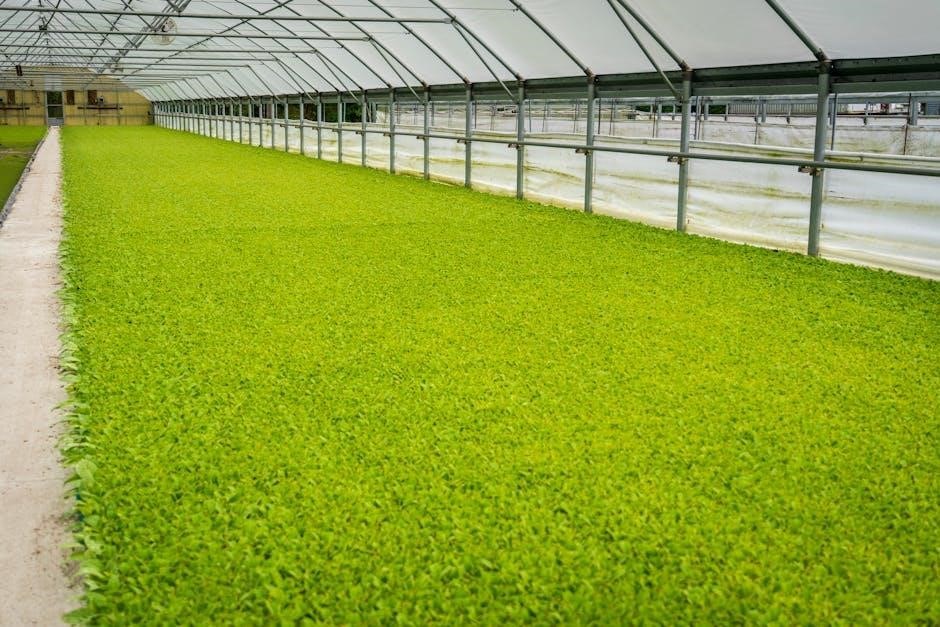Hydroponics is a modern, soilless farming method using nutrient-rich water․ Garden Cube offers a compact, indoor gardening system, enabling efficient plant growth and fresh produce year-round with minimal space․
What is Hydroponics?
Hydroponics is a soilless plant cultivation method using nutrient-rich water to feed roots․ It promotes efficient water use and faster growth compared to traditional gardening; Plants thrive in controlled environments with precise nutrient delivery, often under LED grow lights․ This system supports year-round growing and is ideal for indoor spaces․ Hydroponics minimizes land use and reduces water waste, making it eco-friendly․ It’s versatile for growing herbs, vegetables, and flowers, ensuring fresh produce with optimal resource utilization․

Understanding the Garden Cube System
The Garden Cube is an innovative hydroponic system designed for indoor gardening, offering a compact and efficient way to grow plants․ It uses LED grow lights to simulate sunlight, promoting photosynthesis, and a nutrient delivery system to feed plants directly․ The system is space-saving, ideal for urban environments, and allows year-round growing․ It includes grow pods, a control panel for monitoring conditions, and a water circulation system to ensure optimal nutrient uptake․ This setup enables faster growth rates and higher yields compared to traditional gardening methods, making it a popular choice for home gardeners and urban farmers․

Benefits of Using Garden Cube Hydroponics
Garden Cube Hydroponics offers efficient water and nutrient use, faster plant growth, and reduced space requirements․ It enables year-round indoor gardening, ensuring fresh produce anytime, anywhere․
Space-Saving and Indoor Gardening
The Garden Cube Hydroponics system is designed to maximize space efficiency, making it ideal for indoor gardening․ Perfect for apartments, kitchens, or small areas, it eliminates the need for a large backyard․ The compact design allows growers to cultivate fresh produce year-round, regardless of weather conditions․ With its vertical and controlled environment, the Garden Cube optimizes growing conditions while minimizing space usage․ This makes it a practical solution for urban dwellers who want to grow their own food without compromising on space or yield․ Its indoor capabilities ensure consistent growth and fresh harvests anytime․
Increased Growth Rate Compared to Traditional Gardening
Garden Cube Hydroponics accelerates plant growth significantly compared to traditional gardening․ By delivering optimized nutrients directly to roots and maintaining a controlled environment, plants grow up to 5 times faster․ The LED grow light ensures consistent photosynthesis, while precise water and nutrient delivery eliminate waste․ This targeted system promotes healthy root development and robust plant growth․ Herbs, leafy greens, and vegetables thrive in this setup, often ready for harvest in weeks rather than months․ The controlled conditions also reduce variables like weather and soil quality, ensuring faster and more reliable growth compared to outdoor gardens․
Water and Nutrient Efficiency
The Garden Cube system excels in water and nutrient efficiency, minimizing waste through its closed-loop design․ Nutrient-rich water is recirculated, ensuring plants receive exactly what they need․ This method uses up to 90% less water compared to traditional farming, making it eco-friendly․ The precise delivery system prevents overwatering and nutrient burn, optimizing plant health․ This efficiency not only conserves resources but also reduces environmental impact, aligning with sustainable gardening practices․ The system’s design ensures maximum absorption of nutrients, promoting healthy plant growth while being mindful of resource conservation․
Year-Round Growing Capability
The Garden Cube allows for year-round growing by simulating optimal outdoor conditions indoors․ Its LED grow lights provide consistent photosynthesis, while temperature and humidity controls maintain ideal environmental conditions․ This eliminates seasonal constraints, enabling gardeners to grow fresh produce regardless of weather or time of year․ The system’s efficiency ensures continuous plant growth, making it perfect for indoor gardening enthusiasts․ With the Garden Cube, you can enjoy a bountiful harvest every month, adding fresh flavors to your meals without relying on seasonal availability․ This capability makes it a reliable choice for sustainable and consistent food production․
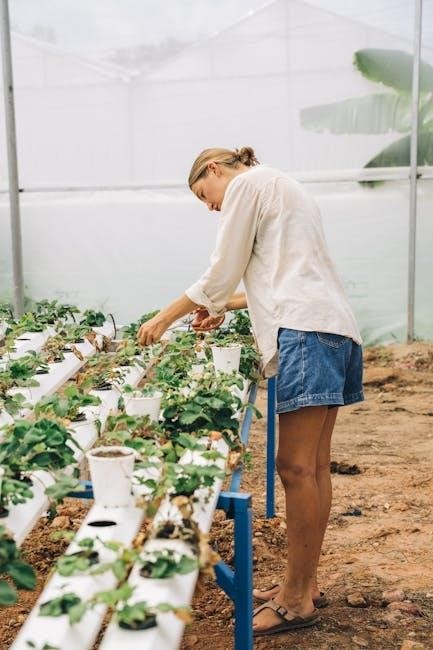
Essential Components of the Garden Cube System
The Garden Cube includes LED grow lights, a nutrient delivery system, grow pods, and a control panel to monitor and optimize growing conditions for maximum plant growth․
LED Grow Light for Photosynthesis
The LED grow light in the Garden Cube system mimics natural sunlight, essential for photosynthesis․ With a 24-watt output, it promotes healthy plant growth and faster development․ The light spectrum is tailored to support leaf growth and flower production, ensuring optimal energy absorption․ Its energy-efficient design minimizes power consumption while maximizing output․ The LED light is a critical component, enabling year-round indoor gardening by replicating seasonal light conditions․ Regular light cycles are programmed via the control panel to simulate day and night, ensuring balanced growth․ This feature makes the Garden Cube ideal for growers seeking consistent, high-quality plant development indoors․
Nutrient Solution and Delivery System
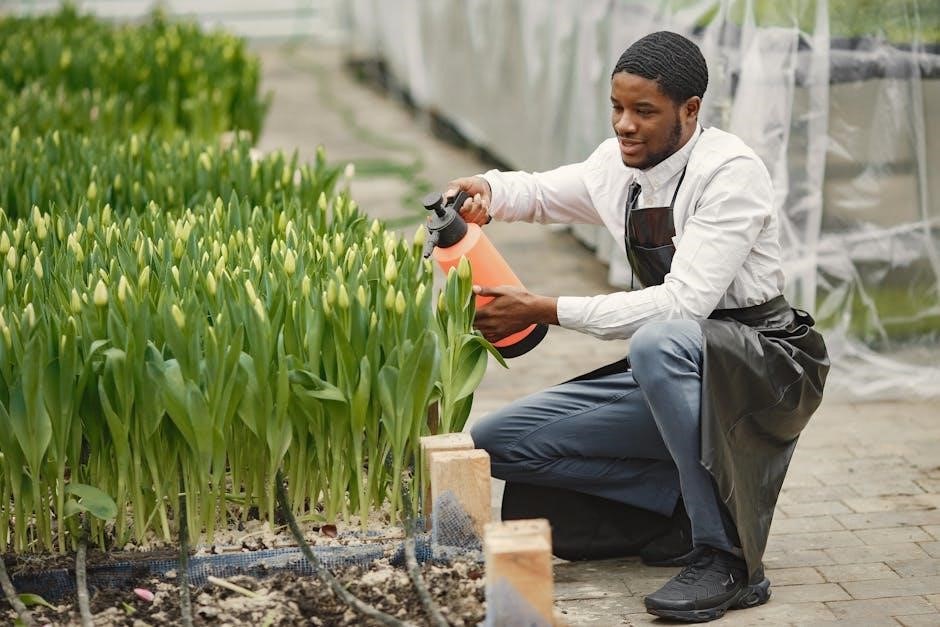
The Garden Cube’s nutrient solution and delivery system ensure plants receive essential minerals and vitamins․ The system circulates a balanced mix of nutrients directly to roots, optimizing absorption․ A pre-formulated solution is added to water, providing nitrogen, phosphorus, and potassium for robust growth․ Automated delivery ensures consistent feeding, reducing overwatering risks․ Regular monitoring of nutrient levels through the control panel maintains plant health․ This efficient system promotes faster growth and higher yields compared to traditional gardening methods, making it a key feature of the Garden Cube’s hydroponic design․ Proper nutrient management is vital for achieving optimal results in hydroponic gardening․
Grow Pods or Planters
The Garden Cube system utilizes grow pods or planters designed to hold plants and their root systems․ These pods are typically made of durable, food-grade materials, ensuring safety and longevity․ They provide adequate space for root growth and are filled with a soilless growing medium, such as coco coir or rockwool, which supports plant stability․ The pods are strategically positioned to optimize space and integrate seamlessly with the nutrient delivery system․ Proper placement and maintenance of the grow pods ensure healthy root development and efficient nutrient uptake, promoting robust plant growth․ Regular inspection of the pods helps maintain optimal growing conditions for your hydroponic garden․
Control Panel for Monitoring Conditions
The control panel is the central hub for monitoring and managing the Garden Cube system․ It allows users to track key parameters such as pH levels, water temperature, and nutrient flow in real time․ Equipped with advanced sensors, the panel automates adjustments to maintain optimal growing conditions․ It also controls the LED lighting schedule and ensures proper water circulation․ Alerts are triggered if levels fall out of the desired range, enabling quick corrections․ This intelligent system simplifies hydroponic gardening by providing precise control and peace of mind․ Regular monitoring through the control panel ensures a healthy and thriving indoor garden year-round․
Setting Up Your Garden Cube
Setting up your Garden Cube involves unboxing and assembling the system, positioning it in your space, connecting components, and testing functionality to ensure optimal performance․
Unboxing and Assembly Instructions
Unboxing your Garden Cube is an exciting first step․ Carefully open the package and inspect all components, including the grow pods, LED light, control panel, and frame․ Begin by thoroughly washing your hands to ensure cleanliness․ Next, assemble the frame according to the provided manual, ensuring all parts are securely locked․ Attach the LED grow light to the designated area and connect it to the control panel․ Insert the grow pods into their slots, making sure they fit snugly․ Finally, place the system in your chosen location and test all components to ensure proper functionality before planting․
Positioning the System in Your Space
Positioning your Garden Cube is crucial for optimal plant growth․ Place it in a stable, flat surface away from direct sunlight to avoid overheating․ Ensure it’s in a well-ventilated area to maintain proper air circulation․ Avoid placing it near windows or doors to prevent drafts․ Keep it out of reach of children and pets to avoid accidental damage․ Ideally, position it near a power source for easy access to the control panel․ Ensure the system is level to maintain even water distribution․ Proper placement ensures a stable environment for your plants to thrive throughout the growing cycle․
Connecting and Testing the LED Light
After assembling your Garden Cube, connect the LED grow light to the control panel using the provided cables․ Ensure all connections are secure to avoid electrical issues․ Plug the system into a nearby power outlet and turn it on․ Check that all LED lights illuminate evenly and cycle through their settings as programmed․ Test the different light modes (e․g․, vegetative, flowering) to ensure proper functionality․ If any lights fail to turn on, refer to the troubleshooting guide or contact customer support․ Proper light operation is essential for photosynthesis and plant growth․
Preparing the Nutrient Solution
To prepare the nutrient solution for your Garden Cube, mix the hydroponic fertilizer with water according to the manufacturer’s instructions․ Ensure the water is clean and free of impurities․ Use a pH tester to adjust the solution to the optimal range for your plants (typically 5․5–6․5)․ Stir thoroughly to dissolve all nutrients evenly․ Pour the solution into the reservoir, making sure not to overfill․ Regularly monitor and replenish the solution as plants grow, following the system’s guidelines for nutrient levels․ Proper preparation ensures healthy root development and nutrient absorption․
Planting and Growing in the Garden Cube
Planting involves selecting suitable hydroponic plants, starting seeds, and transplanting them into grow pods․ Monitor pH, nutrient levels, and light cycles for optimal growth․
Choosing the Right Plants for Hydroponics
Selecting suitable plants for hydroponics is crucial․ Leafy greens like kale, spinach, and lettuce thrive in hydroponic systems due to their compact growth․ Herbs such as basil, mint, and cilantro also excel indoors․ Cherry tomatoes, cucumbers, and strawberries are popular choices for their high yield and adaptability․ Avoid root vegetables like carrots or potatoes, as they require deep soil․ Compact or dwarf varieties are ideal for space-saving systems like the Garden Cube․ Ensure plants have shorter growth cycles to maximize productivity and freshness year-round․
Starting Seeds and Transplanting
Begin by germinating seeds in a seed starter kit or small pods filled with a hydroponic medium․ Ensure the environment is warm and moist to promote germination․ Once seeds develop their first set of leaves, they are ready for transplanting․ Gently place the seedlings into the Garden Cube’s grow pods, taking care not to disturb the roots․ Secure the plants firmly and adjust the system’s water flow to accommodate the new growth․ Monitor the seedlings closely during the first week to ensure proper adaptation․ Transplanting at the right time maximizes growth potential and ensures a healthy start for your hydroponic plants․
Monitoring and Adjusting pH Levels
Regularly monitoring and adjusting pH levels is crucial for optimal plant growth in the Garden Cube․ Hydroponic plants typically thrive in a pH range of 5․5 to 7․0․ Use a pH test kit or digital meter to check the nutrient solution twice a week; If the pH is too high, add a pH-lowering solution, and if too low, add a pH-raising solution․ Changes should be made in small increments to avoid shocking the plants․ Maintain stability by testing after each adjustment․ Consistent pH levels ensure proper nutrient absorption, promoting healthy root function and robust plant development․
Providing Adequate Light Cycles
Light cycles are essential for plant growth in the Garden Cube․ Most plants require 18-24 hours of light during the vegetative stage and 12-18 hours during flowering․ Use the LED grow light provided, ensuring it’s set according to the plant’s growth stage․ Avoid overexposure, as it can stress plants․ Maintain a consistent cycle to regulate photosynthesis and promote healthy development․ Adjust timers regularly and monitor plant responses to optimize growth․ Proper lighting schedules ensure energy efficiency and maximize yield in your hydroponic system․
Pruning and Training Plants for Optimal Growth
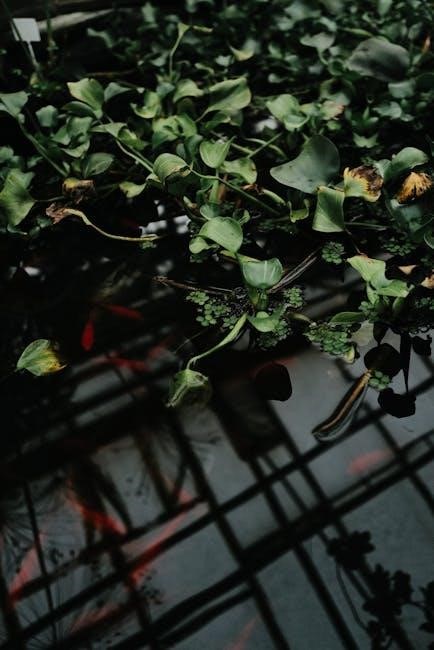
Pruning and training plants in the Garden Cube are crucial for maximizing space and promoting healthy growth․ Regularly trim lower leaves to improve airflow and prevent moisture buildup․ Use trellises or stakes to train vining plants like tomatoes or cucumbers, keeping them upright and organized․ Prune any weak or overgrown branches to redirect energy to productive areas․ This technique enhances light distribution, reduces overcrowding, and increases yield․ Monitor plant structure regularly and adjust pruning schedules based on growth patterns․ Proper pruning ensures efficient nutrient uptake and supports robust plant development in your hydroponic system․
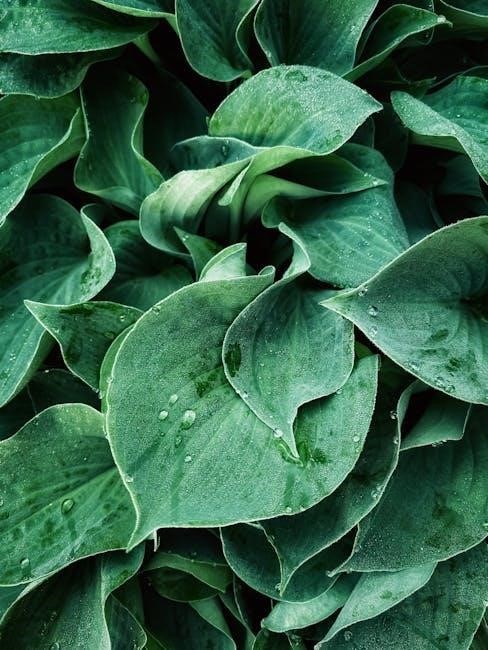
Maintenance and Care Tips
Regularly clean the system, check water flow, and monitor nutrient levels to ensure optimal plant health and system efficiency in your Garden Cube hydroponics setup․
Cleaning the System to Prevent Algae Growth
Regular cleaning is essential to prevent algae growth in your Garden Cube․ Start by draining the nutrient solution and rinsing all components with clean water․ Use a soft brush to scrub away visible algae buildup on surfaces․ For tougher areas, mix a solution of water and white vinegar and soak the parts for 10-15 minutes․ Avoid using harsh chemicals, as they can damage the system or harm plants․ After cleaning, thoroughly rinse everything with fresh water before refilling the reservoir․ This routine helps maintain a healthy environment for your plants and ensures optimal system performance․ Regular maintenance also prevents clogs and keeps the nutrient delivery system functioning smoothly․ By staying proactive, you can enjoy a thriving indoor garden year-round․
Monitoring Nutrient Levels and Replenishment
Monitoring nutrient levels is crucial for plant health in your Garden Cube․ Use a nutrient test kit to regularly check NPK (Nitrogen, Phosphorus, Potassium) levels in the solution․ Over time, plants absorb these nutrients, so replenishment is necessary․ Refer to the manufacturer’s instructions for the recommended schedule and dosage․ Avoid over-fertilizing, as this can cause nutrient burn․ Maintain a balanced solution by adding nutrients gradually and monitoring plant responses․ Adjusting nutrient ratios can also be beneficial during different growth stages, such as increasing phosphorus for root development or flowering․ Consistent monitoring ensures optimal nutrient availability, promoting healthy plant growth and maximizing yields․ Regular checks prevent deficiencies and maintain system efficiency, keeping your plants thriving throughout their lifecycle․
Regularly Checking and Maintaining Water Flow
Regularly inspecting and maintaining water flow in your Garden Cube is essential for plant health․ Check the system’s pumps and tubes to ensure continuous circulation, as stagnant water can harm roots․ Clean or replace clogged filters to maintain proper flow and prevent nutrient buildup․ Monitor water levels to avoid overfilling or depletion, which can disrupt plant growth․ Inspect drainage holes to ensure excess water flows out properly, preventing root rot․ Adjust flow rates if necessary to meet plant needs․ Regular maintenance prevents water flow issues, ensuring roots receive adequate oxygen and nutrients for healthy growth;
Inspecting Plants for Pests or Diseases
Regularly inspect your plants for signs of pests or diseases, as these can quickly spread in a hydroponic system․ Check leaves, stems, and roots for unusual discoloration, holes, or fuzzy growth․ Common pests like spider mites, mealybugs, and aphids can damage plants․ Look for eggs, white powdery residue, or sticky substances like honeydew․ If you spot any issues, isolate affected plants to prevent contamination․ Treat infestations with neem oil, insecticidal soap, or other organic solutions․ Maintain good airflow and hygiene to prevent fungal diseases and root rot, ensuring healthy growth in your Garden Cube system․
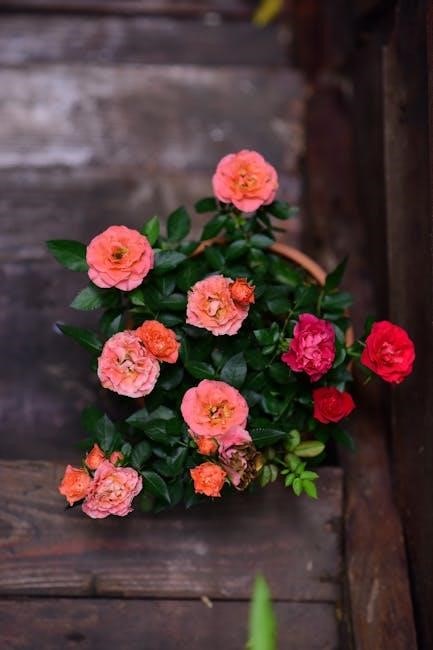
Harvesting Your Crop
Harvest your plants when they reach maturity, typically indicated by vibrant color, firm texture, or the Garden Cube’s growth stage alerts․ Carefully snip or pluck produce to avoid damage, ensuring optimal flavor and freshness for immediate use or storage․
Understanding When Your Plants Are Ready
Determining harvest time requires observing plant characteristics․ For leafy greens like lettuce, harvest when leaves reach 4-6 inches․ For herbs, pick when fragrant and flowers form․ Vegetables signal readiness through color change, like tomatoes turning red․ Check seed package instructions for specific maturity dates; Monitor the Garden Cube’s growth tracker, which alerts when plants are mature․ Avoid early harvesting to ensure full flavor and nutrient content․ Regularly inspect plants to catch the optimal window for each crop type, ensuring a bountiful and delicious yield from your hydroponic system․
Best Practices for Harvesting Different Plants
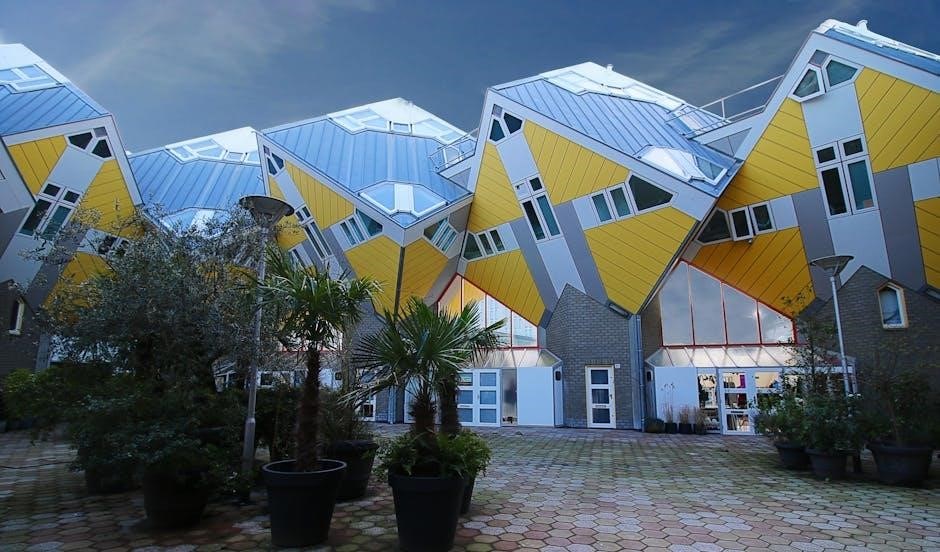
Harvest plants at peak freshness by using clean, sharp tools to prevent damage․ For leafy greens, pinch or cut stems at the base․ Herbs like basil can be trimmed continuously to encourage growth․ Harvest vegetables like tomatoes or cucumbers when fully colored and firm․ Use scissors for delicate stems and hand-pick for larger produce․ Avoid over-handling roots to prevent bruising․ Check the Garden Cube’s growth tracker for precise timing․ Harvest in the morning for highest nutrient content․ Rotate picking to ensure even growth and maximize yield․ Store harvested produce properly to maintain freshness and flavor․
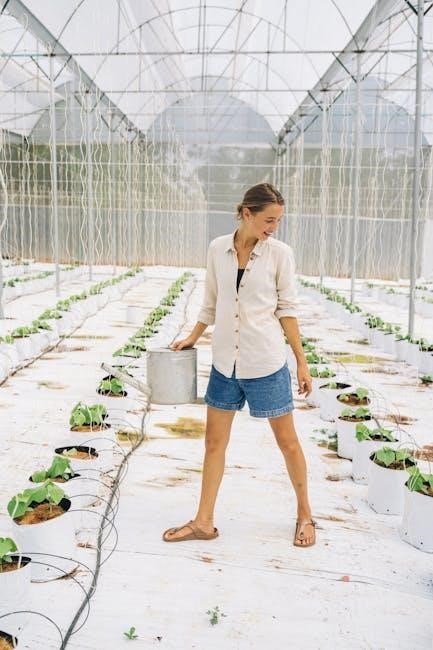
Comparisons with Other Hydroponic Systems
The Garden Cube stands out for its compact design and high efficiency․ Unlike other systems, it offers a user-friendly experience with lower space requirements and cost-effective solutions․
Garden Cube vs․ Traditional Soil Gardening
The Garden Cube hydroponic system offers several advantages over traditional soil gardening․ It requires less space, making it ideal for indoor or small areas, and eliminates the need for soil preparation․ Plants grow faster due to direct nutrient delivery, and water usage is significantly reduced․ Unlike soil gardening, the Garden Cube allows year-round growing regardless of weather conditions․ It also minimizes weed growth and soil-borne pests, reducing maintenance․ However, it requires initial setup and monitoring of nutrient levels․ Overall, the Garden Cube provides a modern, efficient alternative to traditional gardening methods, making it perfect for urban growers․
Garden Cube vs․ Other Indoor Hydroponic Kits
The Garden Cube stands out among indoor hydroponic kits with its compact, user-friendly design and advanced features․ Unlike many kits, it offers a fully enclosed system, optimizing growth and minimizing mess․ Its LED lighting and automated nutrient delivery system ensure consistent plant health․ While other kits may require more manual adjustments, the Garden Cube streamlines the process, making it accessible for beginners․ Additionally, its space-saving design rivals larger systems, providing a practical solution for small indoor spaces․ Overall, the Garden Cube balances efficiency, ease of use, and performance, making it a strong competitor in the hydroponic market․
Advanced Techniques for Optimized Growth
Customizing light spectra and adjusting CO2 levels can significantly enhance plant development․ These techniques, when applied correctly, promote robust growth and maximize yield in the Garden Cube system․
Using CO2 Supplementation
CO2 supplementation significantly enhances plant growth by accelerating photosynthesis․ In the Garden Cube, maintaining CO2 levels between 1200-1500 ppm optimizes light absorption and nutrient use․ This advanced technique boosts leaf growth and flower production, ensuring healthier plants․ Regular monitoring ensures CO2 levels remain balanced, preventing over-supplementation․ Proper ventilation is crucial to avoid CO2 buildup, which can harm plants․ By integrating CO2 systems, gardeners can achieve faster growth rates and higher yields, making it a valuable upgrade for experienced users of hydroponic systems like the Garden Cube․
Adjusting Nutrient Ratios for Different Growth Stages
Nutrient ratios must be tailored to plant growth stages for optimal results․ During germination, focus on balanced NPK levels to support root development․ In the vegetative stage, increase nitrogen for leaf growth and phosphorus for energy production․ Flowering plants benefit from higher potassium and phosphorus to promote bud formation․ Regularly test and adjust nutrient concentrations to avoid deficiencies or burn․ Monitoring plant responses ensures precise adjustments, maximizing growth potential․ This customization is key to achieving healthy, thriving plants in the Garden Cube hydroponic system․
Common Mistakes to Avoid
Overwatering and nutrient burn are frequent issues in hydroponics․ Excess water can cause root rot, while too many nutrients damage plants․ Monitor levels carefully to avoid these pitfalls․
Overwatering and Nutrient Burn
Overwatering is a common mistake in hydroponics, as it can lead to root rot and oxygen deprivation․ Similarly, excessive nutrient levels can cause nutrient burn, damaging plant roots and leaves․ Symptoms include yellowing leaves, stunted growth, and tip burn․ To avoid this, ensure proper drainage in your Garden Cube system and monitor nutrient levels regularly․ Start with a balanced fertilizer at half the recommended strength and gradually increase as plants grow․ Regular water changes and pH monitoring can also prevent these issues․ Always follow the manufacturer’s guidelines for nutrient application to maintain healthy plant growth․
Insufficient Lighting or Incorrect Spectrum
Insufficient lighting or using the wrong spectrum can significantly hinder plant growth in hydroponics․ LED grow lights are essential for photosynthesis, and their intensity, duration, and color spectrum must match the plant’s growth stage․ Incorrect spectra may cause weak stems or delayed flowering․ Ensure your Garden Cube’s LED light provides a balanced spectrum, typically in the 400-700nm range, with adjustable settings for veg and bloom phases․ Position lights at the recommended height to avoid burning leaves․ Regularly monitor plant responses and adjust lighting schedules to optimize growth and prevent stunted development․ Proper lighting is critical for maximizing yields in any hydroponic system;
Troubleshooting Common Issues
Troubleshooting common issues in Garden Cube hydroponics involves identifying problems like nutrient deficiencies or pump failures․ Regular system checks and adjustments ensure optimal plant health and growth․
Diagnosing and Fixing Plant Deficiencies
Plant deficiencies in hydroponics often stem from nutrient imbalances or pH fluctuations․ Yellowing leaves may indicate nitrogen deficiency, while stunted growth could signal lack of potassium․ Iron deficiency causes yellowing between leaf veins․ To fix these issues, adjust nutrient ratios and monitor pH levels regularly․ Ensure proper light cycles and nutrient delivery․ Regular water changes and replenishing nutrients can prevent deficiencies․ Inspect plants daily for signs of stress, and consult the Garden Cube system guide for specific nutrient recommendations․ Early detection and correction are key to maintaining healthy plant growth in your hydroponic setup․
Resolving Pump or Water Flow Problems
Pump or water flow issues in the Garden Cube can disrupt nutrient delivery, affecting plant health․ First, check if the pump is powered on and functioning․ Ensure water tubes are not blocked or kinked, as this can restrict flow․ Verify that water levels are within the recommended range, as low levels can cause the pump to malfunction․ Clean or replace clogged tubes and ensure all connections are secure․ If issues persist, inspect the pump for wear or debris and replace it if necessary․ Regular maintenance and inspections can prevent such problems, ensuring optimal water circulation for healthy plant growth․
The Garden Cube hydroponic system offers a revolutionary way to grow plants indoors, combining efficiency, space-saving design, and ease of use for gardeners of all skill levels․
The Garden Cube hydroponic system provides an innovative, space-efficient way to grow plants indoors․ It combines advanced LED lighting, precise nutrient delivery, and automated monitoring for optimal growth․ Users appreciate its ease of use and ability to produce fresh produce year-round․ While it may require a slight learning curve, the system is designed to accommodate both beginners and experienced gardeners․ The compact design and water efficiency make it a sustainable option for urban spaces․ Overall, the Garden Cube offers a rewarding and futuristic approach to gardening, empowering users to cultivate their favorite plants with minimal effort and maximum yield․
Encouragement and Next Steps for Gardeners
Embrace your journey with Garden Cube hydroponics and enjoy the thrill of nurturing your plants․ Start small, experiment with different crops, and gradually refine your techniques․ Share your progress with gardening communities for inspiration and advice․ Explore advanced methods like CO2 supplementation and nutrient adjustments to maximize growth․ Remember, hydroponics is a skill that improves with practice․ Keep learning, stay curious, and watch your indoor garden flourish․ Happy growing!
